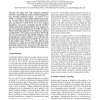688 search results - page 50 / 138 » Using reinforcement learning to adapt an imitation task |
NECO
2007
13 years 7 months ago
2007
Learning agents, whether natural or artificial, must update their internal parameters in order to improve their behavior over time. In reinforcement learning, this plasticity is ...
CEC
2005
IEEE
13 years 9 months ago
2005
IEEE
We apply XCS with computed prediction (XCSF) to tackle multistep reinforcement learning problems involving continuous inputs. In essence we use XCSF as a method of generalized rein...
ICML
2010
IEEE
13 years 5 months ago
2010
IEEE
Temporal difference (TD) algorithms are attractive for reinforcement learning due to their ease-of-implementation and use of "bootstrapped" return estimates to make effi...
MLDM
2009
Springer
14 years 2 months ago
2009
Springer
This work presents an image analysis framework driven by emerging evidence and constrained by the semantics expressed in an ontology. Human perception, apart from visual stimulus a...
AI
1998
Springer
13 years 7 months ago
1998
Springer
Reinforcement Learning (RL) is the study of programs that improve their performance by receiving rewards and punishments from the environment. Most RL methods optimize the discoun...

